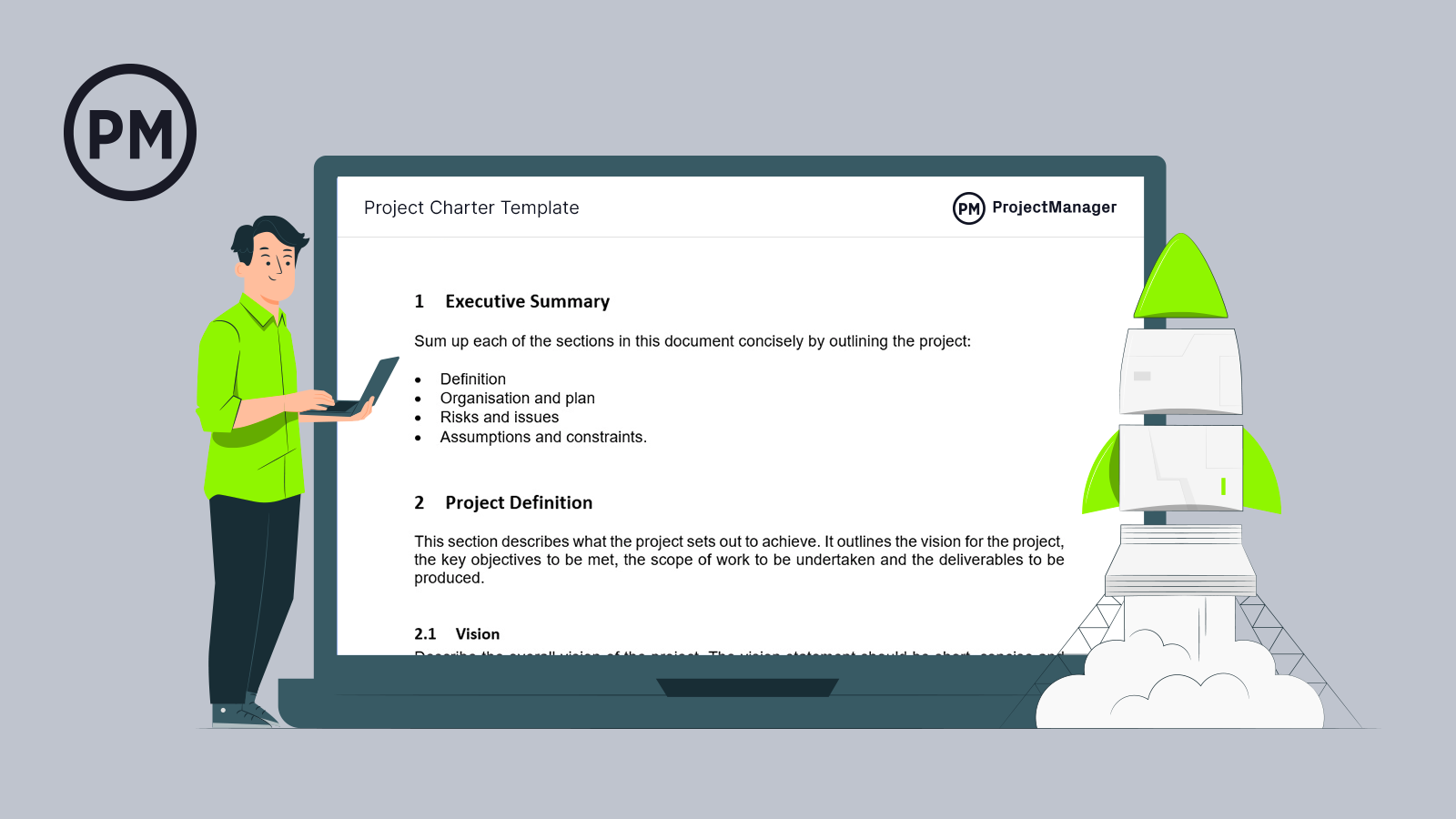This project charter template allows you to document all the general information about your project such as its scope, stakeholders, deliverables, goals and objectives, among other things. Once you identify those, you can then build out task lists as well as resource, financial and quality plans to outline the scope of work ahead. Your project charter is an important document because it provides an easy-to-understand overview of your project so that everyone involved is on the same page.
What Is a Project Charter Template?
As defined by the Project Management Institute in the Project Management Body of Knowledge (PMBOK) book, a project charter “documents the high-level information on the project” to ensure a common understanding by the stakeholders of the project deliverables, milestones and the roles and responsibilities of the project management team.
Therefore, a project charter template is simply a form that allows project sponsors to easily create a project charter with the information that stakeholders and decision-makers need to evaluate a project and decide whether to move forward with it or not, which is especially helpful for project-based organizations that execute projects on a regular basis.
Once you have your project team and the project charter has been approved, you may begin using project management software to turn the project charter into a project plan that can be tracked. ProjectManager’s Gantt chart has robust project planning features that allow to make a project schedule, link task dependencies, allocate resources, monitor costs and calculate the critical path. After you set the project schedule baseline, you can track your actual progress against your plan in real time as your team works—keeping your project on schedule and under budget. Try it for yourself with a free 30-day trial.
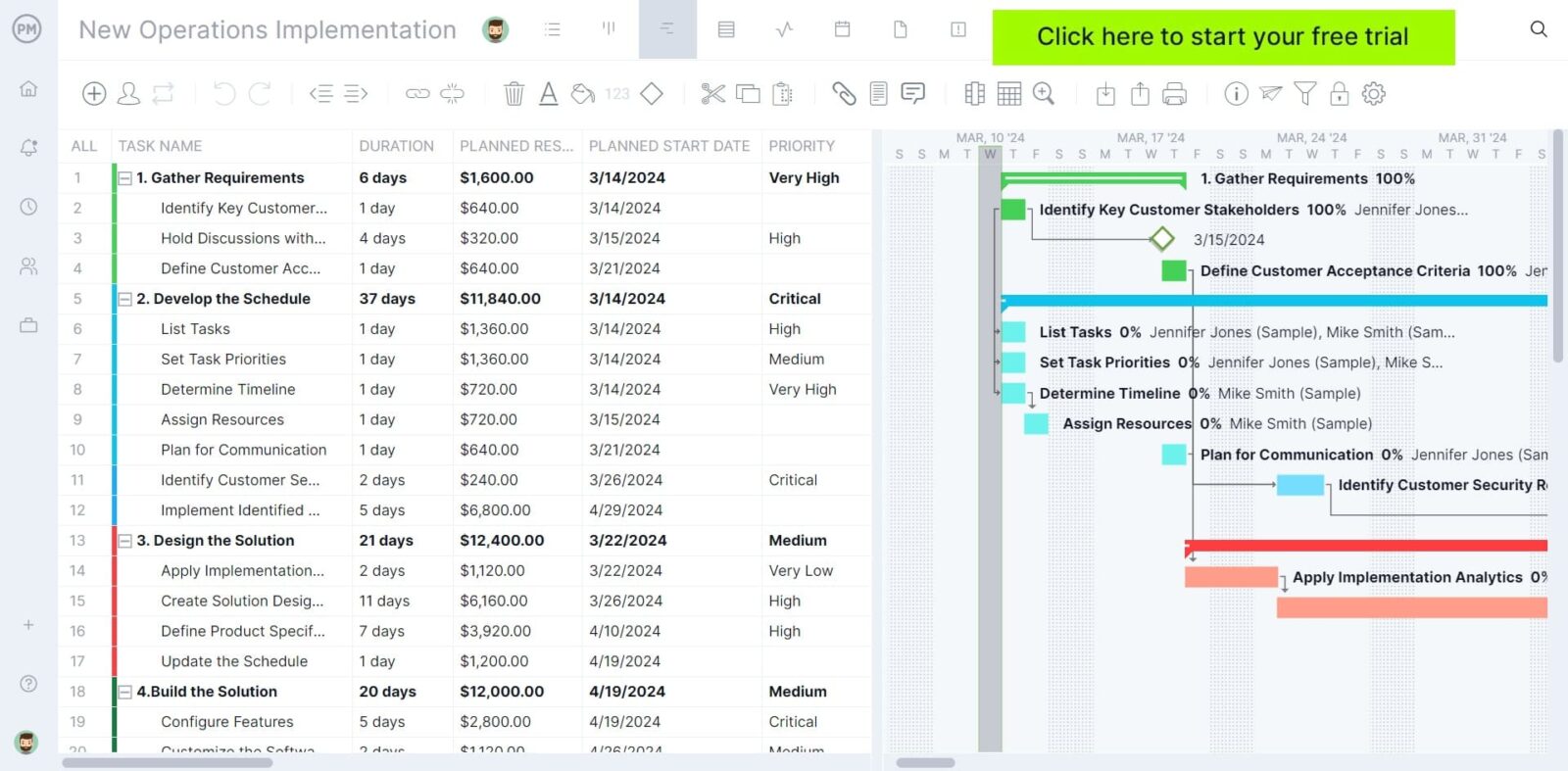
When to Use a Project Charter Template
The project charter template is primarily used during the project initiation phase. Here, the project sponsor will spearhead the creation of the project charter by gathering general information about the project including the objectives, business needs, budget and timelines. They will define the project’s scope, purpose, deliverables, constraints and risks. Often, the project sponsor will collaborate with the project manager or stakeholders to ensure the project is feasible.
When a charter is drafted, the sponsor will present it to decision-makers such as senior executives to get approval. Stakeholders could provide feedback or request adjustments. As soon as the project charter is approved, the project manager is assigned and funding is secured. Again, all of this happens during the initiation phase.
Why You Need a Project Charter Template
There’s a reason for initiating a project, and this project charter template helps outline those reasons. This is very important, as decision-makers will use the project charter to determine whether a project is approved or rejected during the project intake process.
Some of the things described in this project charter template for Word are the vision, objectives, scope and deliverables of the project. Then you’re going to need to address everyone’s responsibilities in the project, from the stakeholders on down. Finally, you want to explain how you are going to take on the project—that covers the project scope, resources, stakeholder requirements, among other things.
To fill out this project charter template, you’ll need to gather information from a couple of other project management documents. These are the business case and feasibility study. Once all these documents and the project charter have been approved, you are ready to begin the project planning phase.
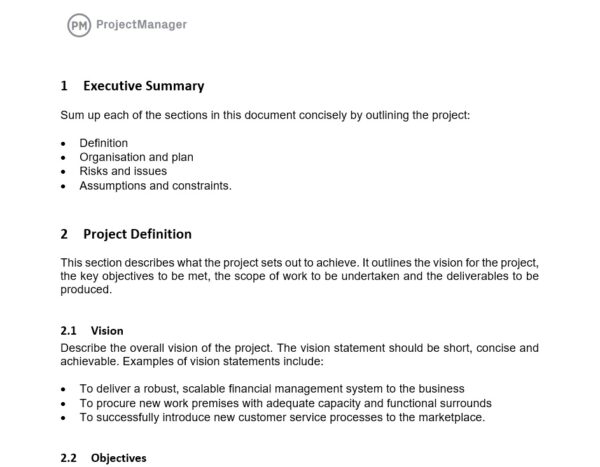
So, what the project charter template is doing is setting the stage for the project plan. You are going into detail about the project’s scope that will account for all the deliverables the project is supposed to achieve. Once you have a project charter then you have to assemble your project team and begin with the planning, execution and monitoring phases.
How to Use this Project Charter Template
Before jumping into the elements of your project charter template, there are steps you can take that will help you deliver a better final product. Like any project, the research and due diligence you put in before the project pays off during the project execution phase.
First, creating the elements of a project charter it’s not a solo mission. While it is often tasked to the project manager, it is smart to get help from the project team members when building the project charter. Before you put word one to paper, lead a meeting that includes everyone who is a project stakeholder, clients and other team members.
It’s important to make this an open discussion, where everyone’s feedback is heard and, better yet, put to paper. This collects ideas and different perspectives for your project charter, but it also serves to help everyone involved in the project planning stay informed and avoid any misunderstandings.
This meeting is a wealth of data for you to analyze. Review your notes and when you start a project charter draft, show it to the team members who attended the meeting. They might have more ideas or revisions that you can use to update your project charter template.
Who Should Use This Project Charter Template?
Various roles within the organization may use a free project charter template. We’ve outlined a handful of examples.
- Project Sponsor: The project sponsor will utilize the project charter template to fill out details about the project’s business case and how it aligns with the organizational strategy. It will help secure funding and communicate the purpose of the project to stakeholders so that they understand its high-level objectives. As the project eventually progresses, the sponsor will refer to the charter to ensure it aligns with the initial goals.
- Project Management Office (PMO): The PMO will also utilize a project charter template to look at and standardize project alignment with organizational priorities and resource constraints. They look at the charter to ensure it’s feasible and that all the necessary components (risks, scope, objectives) are documented. They may also use a charter to assign responsibilities and support the project manager with methodologies or tools. The charter will act as a reference point for portfolio management to ensure the project is contributing to larger strategic initiatives.
- Project Manager: Think of the project charter as a roadmap that the project manager will use to guide project planning, execution and decision-making. This project document offers clarity on scope, objectives and deliverables so that the project manager can develop a detailed plan. The charter also helps identify stakeholders and their roles so the project manager can better determine what engagement and communication strategies will be the most effective.
- Department Heads and Functional Managers: Department heads and functional managers will also use a project charter template so they can understand their project responsibilities, roles and resource commitments. It offers them a clear understanding of how their departments’ deliverables will make up the overall project objectives. Managers will use the charter to plan assignments for their project team, allocate resources and coordinate with other departments to ensure there are no conflicts.
What Is Included in This Project Charter Template?
As with most project management documents, the elements of a project charter might vary from one project to another.
To simplify things, let’s divide this project charter template into 5 sections.
- Project Charter Template Section 1: Executive Summary, Project Purpose, Goals and Success Criteria
- Project Charter Template Section 2: Project Scope, Quality Management and Timeline
- Project Charter Template Section 3: Resources, Costs and Budget
- Project Charter Template Section 4: Project Team and Stakeholders
- Project Charter Template Section 5: Change and Risk Management
Project Charter Template Section 1: Executive Summary, Project Purpose, Goals and Success Criteria
In this section you’ll define the purpose of the project, its goals and objectives and success criteria.
Executive Summary
An executive summary is where you sum up the various sections that will follow in greater detail in this document. Be concise, you are only outlining what will come, like a table of contents. This part of the document will cover the definition, organization and plan, risks and issues and assumptions and constraints.
Project Purpose and Vision
You must have a clear picture of -what the project is in place to achieve, and here is where you want to state that purpose and the high-level project description. Our free project charter template for word includes the following sections for your project definition.
To describe the vision of the project, be concise. The project purpose should be said in only a sentence that defines the problem or opportunity being addressed. Boil it down, and don’t forget to make it achievable.
Project Goals and Objectives
For the project objectives, you want to list those crucial to the project. Each objective should be a statement that details what the project is going to achieve. These must be specific, measurable, achievable, realistic and time-bound, which can be easily remembered as the acronym S.M.A.R.T.
The project objectives can be broken down into sub-objectives. These can include business-specific business objectives. There are also technology-specific project objectives.
Project Success Criteria
In this section, you’ll want to list the metrics or standards that will measure whether a project is successful. This makes it easy to set clear expectations and offers a framework for evaluating the project’s performance. Some common success criteria that are included in a project charter include, time, cost, scope, quality, risk management and stakeholder satisfaction, but feel free to make adjustments based on what you want to track.
Project Charter Template Section 2: Project Scope, Quality Management and Timeline
In this section you’ll define the purpose of the project, its goals and objectives and success criteria.
Project Scope
The project scope compiles all the activities, milestones and deliverables of your project. The purpose of your project scope is to set limits to the work that will be executed. When detailing the scope of the project you need to take into account what resources will be needed, which will be further defined in the resource management overview section. Don’t forget to note what will not be included in your project scope and think about the risks and constraints associated with it.
- Task Dependencies: Then you want to list the task dependencies. How will they impact other tasks and will they be impacted by non-delivery, as in are they task-dependent?
- Project Deliverables: The project deliverables can be collected in a chart, such as one that lists the item in one column, followed by its components in another and then the description, success criteria, and quality requirements.
- Project Milestones: You want to know what your milestones will be throughout the project life cycle. Project milestones are major points in a project that marks when a phase is completed. Make a table with the milestone, the date you want it completed and a description of what it is.

Quality Management
Next, define quality standards, quality assurance processes and quality control guidelines from a high-level view. This makes sure the various processes are being done to lead to the success of the project. So, therefore, you want to list the process — be it change management, risk management, issue management, etc. — and then describe it.
Project Timeline
The project timeline section is where there’s a high-level overview of the project schedule. This should include key milestones and target completion dates to help set project expectations and a framework for more detailed project planning.
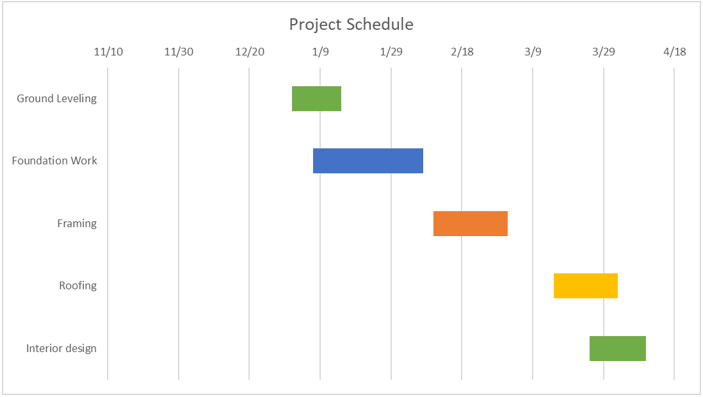
Project Charter Template Section 3: Resources, Costs and Budget
Once the project tasks have been defined, it’s time to identify what resources will be required, what their cost will be. Additionally there’s a cost-benefit analysis section that allows you to compare the estimated costs of the project against potential benefits to determine its value to the organization.
Resource Management
In this section, you are going to summarize the duration and effort of each project team member. Begin with their role, followed by the start and end dates and the percentage of effort.
Now comes the financial part. Here you break down the category to the cost and the value. A more detailed financial plan can be developed in the planning stage of the project.
Estimated Costs and Project Budget
This section includes a high-level overview of the needed resources to complete the project. It can help get the right funding and manage stakeholder expectations. The project’s estimated cost could include labor, material or overhead costs while the total project budget is a list of all costs. This includes labor, materials, equipment, software, travel and overhead.

Cost-Benefit Analysis
A cost-benefit analysis (CBA) in a free project charter template helps justify the project’s resource investment and ensure the project aligns with the organization’s objectives. It can also help get stakeholder buy-in and mitigate risks. Elements of a cost-benefit analysis include direct costs, benefits (both tangible and intangible) and a risk assessment.
Project Charter Template Section 4: Project Team and Stakeholders
Now it’s time to identify who will work in the project, what will be the roles and responsibilities of the project team members and who the project stakeholders are.
Project Team
Now you want to define the roles in the project. What are the various people needed to take on the project? They may include a project sponsor, review group, project manager, team member, et al. Again, you want to collect this information in a table, with columns for role, organization, resource name, assignment status and assignment date. If your project is larger, however, only list the key roles.
What are the responsibilities of the project? That’s the next item to note. For each role listed, you now have to define a full set of responsibilities, performance criteria and the skills required. You want to attach a job description as well.
You next will need to build an organization flow chart that shows the reporting lines between each of the key roles you have already written about.
Project Stakeholders
Project stakeholders have to be considered in this section, as well. List those people who are in or out of the project, but have a key interest.
Start with the customers. Describe who they are and how they will use the project deliverables. These customers can be individuals, but they can also be groups. Remember, the success of the project is dependent on the deliverables matching the requirements and success criteria of the customers. Make a table to collect this information.
Then, there are many internal and external stakeholders, which include company executives, legislative bodies and regulatory bodies. Create a table with stakeholders in one column and why they are interested in the project in another. To do so, this project charter template includes a stakeholder register and a stakeholder matrix.

Project Charter Template Section 5: Change and Risk Management
Now it’s time to identify who will work in the project, what will be the roles and responsibilities of the project team members and who the project stakeholders are.
Change Management
A project charter should explain how changes will be handled once the project starts. To do so, a change control board must be appointed, and a change request form and change log must be created.
Risk Management
Here is where you address the risks in your project. Describe what risk might arise in the project, note the likelihood (high, medium or low), the impact it will have (again: high, medium or low) and the risk management actions you will take if it does happen.
To do so, this free project charter template has a risk log and a risk matrix. The risk log is a chart that allows project management teams to list any potential project risks, while a risk matrix helps prioritize them based on their potential impact and likelihood.
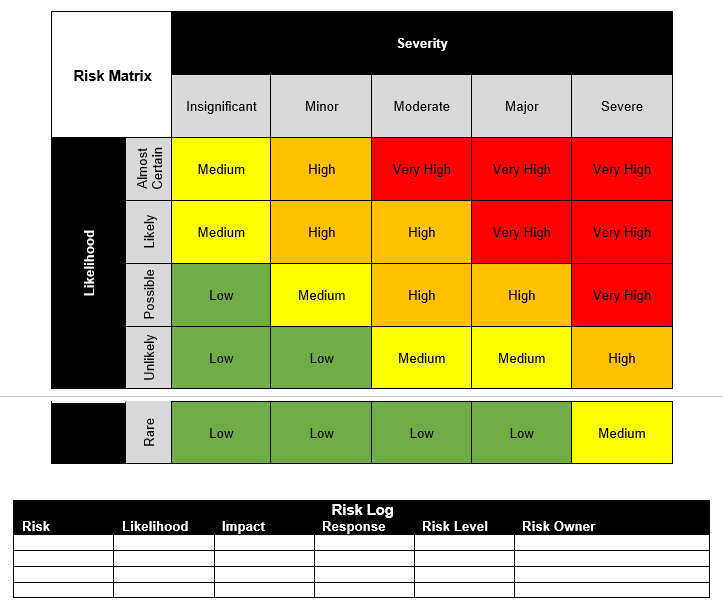
Appendix
Finally, you’ll want to attach any supporting documentation in an appendix.
How ProjectManager Helps Turn a Project Charter Template into a Successful Project
It’s clear that the project charter template is an invaluable resource in laying the project’s foundation. It offers a vision and a framework, but it isn’t a concrete plan. The project charter helps lead to project planning, so ProjectManager is the ideal software you need to plan projects from start to end.
Multiple Project Planning and Scheduling Views
Teams need to have a clear direction so project managers can focus on achieving the project’s long-term goals. Our software offers multiple project planning tools such as our award-winning Gantt chart to plan and schedule projects in detail. Add project tasks, set a baseline and track milestones to avoid bottlenecks. Other views include kanban boards or a calendar view to see at a glance when important deadlines are coming up.
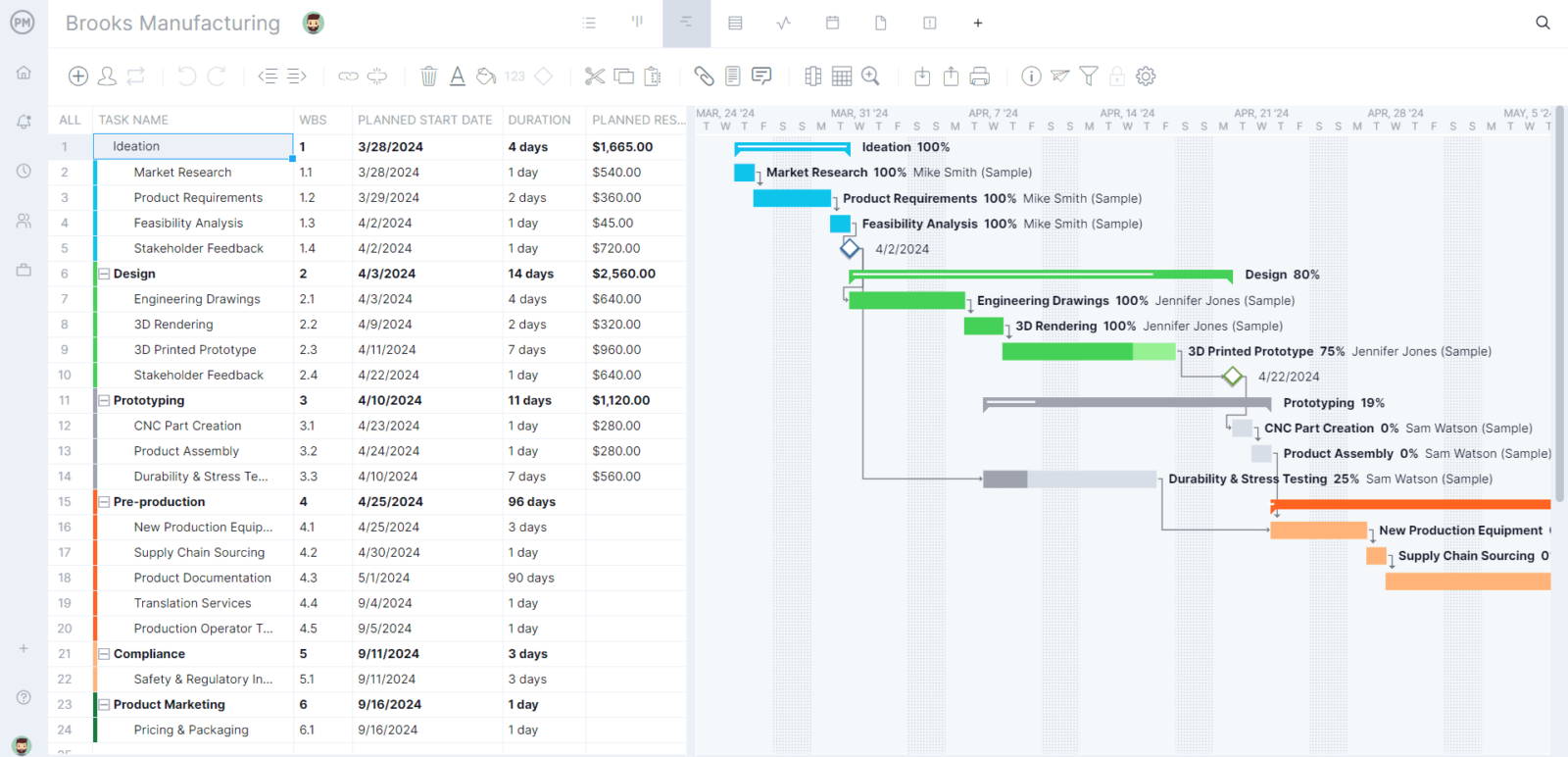
Robust Resource Management Tools and Features
Another important aspect of a successful project is managing resources. In-depth resource management tools and features allow managers to better track their teams’ hours and availability. The team page is the perfect place to get an overview of the team’s current workload where live adjustments can be made. The result is a balanced workload where the team is productive without burning out. Secure timesheets are another tool to leverage to keep track of resources in real time.

Real-Time Project Dashboards
While the project charter focuses on the project planning phase, it’s important to have the tracking tools to monitor projects as they progress. The project and portfolio dashboard is one of the most effective tools for tracking as it automatically captures data across pivotal project metrics. At a glance, project managers can understand where there are bottlenecks and where teams are successful.

What Is the Difference Between a Project Charter, a Statement of Work and a Project Proposal?
Before going any further, we must be clear on the distinction between a project charter and other similar but different project management templates. Let’s look at the main differences between a project charter, a statement of work and a project proposal.
Project Charter vs Statement of Work (SOW)
A statement of work (SOW) explains the reason for the project and an overview of what the deliverables will look like. A project charter, on the other hand, is based on the SOW and gives the project manager the authority for project kick-off. Another difference is that the SOW tends to be an internal document that is used only by the company to address business needs and provide an overview of the deliverables. A project charter, however, comes after the SOW and gives the project manager the authority to kick off the project and spend the budget.
Project Charter vs Project Proposal
As for a project proposal, it’s designed to persuade stakeholders about the viability of the project. Again, the project charter doesn’t start until the project proposal has been sanctioned. The ownership of these documents differs too, in that traditionally the project manager owns the project charter and a project director is the owner of the project proposal.
The project charter is created during the planning phase of a project, while the project proposal takes place during the initiation phase. The project charter is a reference and details the roles and responsibilities of the project team. The project proposal identifies a problem and how to fix it or an opportunity and how to exploit it.
What’s Next?
What do you do after you’ve filled out our free project charter template for Word? The first thing you should do is review it. This is an edit for content and copy. The last thing you want is to have typos, which makes the operation appear unprofessional.
Show the project charter template to the team, your stakeholders and anyone else who helped you create it. Get their feedback and update the document as needed.
At last, you’ll need to get the project charter approved. Send it to your stakeholders and project sponsors for a final review. If they don’t have any questions, then it can be approved and the project work can begin.
The project charter shouldn’t be shelved at this point. It must be available for everyone on the team to use as a reference. It keeps them on task and sure of the project objectives, obstacles and milestones.
Related Content
The ProjectManager blog features regularly published articles and videos on project management, leadership, business and more. Here are a few items that have been recently posted that relate to project charters.
Try ProjectManager Free for 30 Days
Now that you are ready to start your project, you will want to have the right tools to plan, track and report on it. ProjectManager is online collaborative project management software that allows for real-time data collection. We’re repeatedly ranked #1 by Garnter’s GetApp in project management. See why by signing up for our free 30-day trial.
